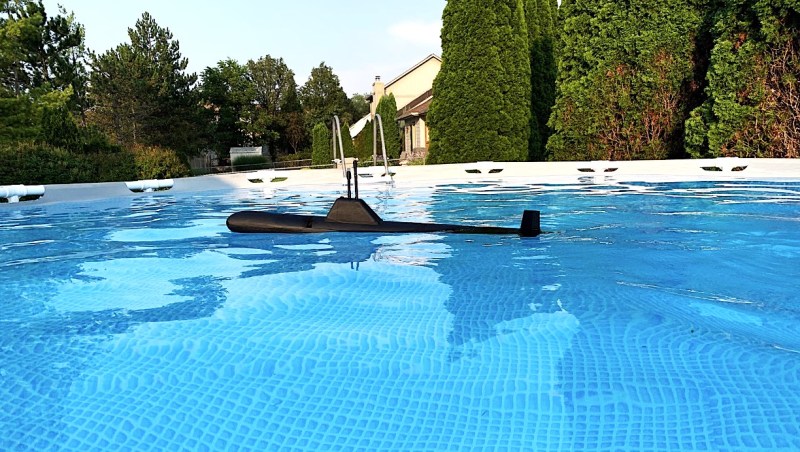[Ben]’s a 15-year-old who loves engineering and loves taking on new challenges. He’s made some cool stuff over the years, but the high water mark (no pun intended) has to be this impressively documented remote controlled submarine.
His new build starts off with more research than the actual building. [Ben] spent a ton of time investigating the design of the submarine from its shape, to the propeller system, to the best way to waterproof everything, keeping his sub in tip-top shape. He decides to go with the Russian-style Akula submarine, which is probably the generic look that most of us would think of when we hear the word submarine. He had some interesting thoughts on the propeller system (like the syringe ballast we’ve seen before), and which type of motor to use. In the end, he decided with four pumps that would act essentially as thrusters. fill a chamber with water, allowing the submarine to submerge, or fill with air, making the submarine buoyant, allowing it to resurface.
However, what we found most interesting about his build is how he explains the rationale for all his design decisions and clearly documents his thought process on his project page. We really can’t do [Ben]’s project justice in a short post, so head over to his project page to see it for yourself.
While you’re at it, check out some of these other cool submarine builds that we’ve featured here on Hackaday
















Hopefully, it won’t implode.
Hopefully!
The concept drawing made me chuckle: “Torpedos?”
Torpedoes actually might have been practical if Estes MicroMax motors, about 1/4″ dia and 1″ long, were still available. They wouldn’t have gone far, since they were intended for backyard launching…but it would have been an impressive touch.
The regular engines worked fine underwater when my “boats” turned into submarines the second they were ignited in the creek next to my house as a kid. Sadly the heavily painted tissue paper balsa frames (scraps from rocket fin cutouts) rarely made it more than 20 feet before collapsing (shredding). Sadly my hydrodynamic engineering was sub-par at age 10. Mounting the engine high in the back to keep them dry until ignition was never compensated by a planing suitable surface on the bottom front.
It’s Quest that makes MicroMaxx motors, and they’re still available.
My mistake, you’re right, they’re a Quest product. But they seem to be awfully hard to find. The question of where to get them comes up periodically on https://www.rocketryforum.com/, and lately it’s rarely answered, if ever. https://www.acsupplyco.com/ carries almost all of the Estes and Quest products (except most parts) at a discount, and I’ve never seen them there. If there’s a vendor out there, please let me know.
Scale torpedoes are a very real thing in the model sub community. One dude somewhere (probably more) even got some ICBMs to launch.
I am building a Submarine myself, and looked at this project for one specific answer- How does the submarine receive commands. The creator has used a RC receiver, which operates at 2.4Ghz. In water, the range is extremely limited. I was wondering how it all worked.
It would be nice if there were some videos to see it in action.
For this sub, it is positively buoyant and requires active use of thrusters to force it underwater. If it dives too deep and the signal is lost, the thrusters will turn off and the sub will float back to the surface. Once back at (or close to) the surface it can receive commands again.
That isn’t what the article says-
“he decided with a pump that would fill a chamber with water, allowing the submarine to submerge, or fill with air, making the submarine buoyant, allowing it to resurface.”
That’s the kind of definition of a static diving sub. The kind where it’s neutral or maybe a tiny bit positive and requires thrusters or dive planes is called dynamic diving.
Yes, but, the HaD article appears to be wrong. Reading what the builder wrote, they claim to use 4 small pumps to move the vessel up and down, although they need use the control surfaces to start the dive (i.e. cover the pumps in water).
Correct. And this is what the builder appears to do. No ballast tanks for achieving neutral buoyancy.
Thanks! I’ll fix this inline.
Doesn’t work under water at all but some people will run a buoy and wire to the surface
Older FM radios still work- 6-8 feet of pool water, a lot more in unchlorinated. And only a few inches in salt water.
Mostly you only run just under the surface in lakes anyway.
if you want to build a submarine
this book is available for next to nothing (german only) and has a ton of info on the subject:
https://www.alles-rund-ums-hobby.de/schiffsmodell/buecher/106/u-boot-modellbau
The master
https://www.secretprojects.co.uk/threads/merrimans-submarine-modelling-masterclass.31899/page-19#post-647422
On the contrary, to avoid complexity and dealing with pressurised air, he went with a fixed ballast and four submersible aquarium pumps as vertical thrusters. As noted the downside is that all four must be submerged before its functional, to counteract that he uses control surfaces and forward thrust initially. I like the simplicity and ominous-looking ports.
Great build!
Thanks. We corrected this inline.
This is a really great build for only being 15. That being said, I’m skeptical of the water tightness of the electronics bag.